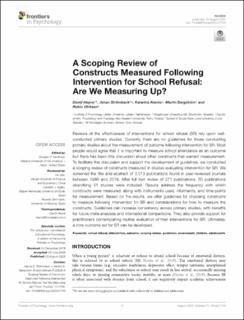| dc.description.abstract | Reviews of the effectiveness of interventions for school refusal (SR) rely upon well-conducted primary studies. Currently there are no guidelines for those conducting primary studies about the measurement of outcome following intervention for SR. Most people would agree that it is important to measure school attendance as an outcome but there has been little discussion about other constructs that warrant measurement. To facilitate this discussion and support the development of guidelines, we conducted a scoping review of constructs measured in studies evaluating intervention for SR. We screened the title and abstract of 3,213 publications found in peer-reviewed journals between 1980 and 2019. After full text review of 271 publications, 50 publications describing 51 studies were included. Results address the frequency with which constructs were measured, along with instruments used, informants, and time-points for measurement. Based on the results, we offer guidelines for choosing constructs to measure following intervention for SR and considerations for how to measure the constructs. Guidelines can increase consistency across primary studies, with benefits for future meta-analyses and international comparisons. They also provide support for practitioners contemplating routine evaluation of their interventions for SR. Ultimately, a core outcome set for SR can be developed. | |
